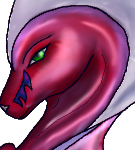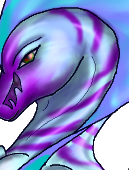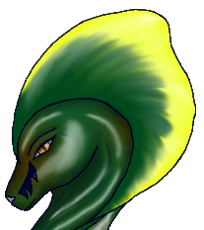

These dragons from another world call themselves the Alaiskya (a-LYE-skya). It is believed that the name means "Celestial Warriors," though even Veritas is unsure of this fact.
The Alaiskya are a sleek race, with soft hide covering their bodies. The ridge that runs along their spine is velvet-soft, and can be raised and lowered slightly depending upon their mood, similar to the way a cat uses their ears to express mood. Their wings are feathered and their paws have pads like a feline, though on the Alaiskya, the dew claw on their front paws is a true thumb. The Alaiskya are capable of manipulating objects by sitting upon their haunches (or flying) and bringing their front paws into play. If they must, they will walk very short distances on their hind legs while carrying something in their forelegs, though they would prefer to either fly or carry it in their mouth.
Coloration is related to what magical specialties the Alaiskya will find the easiest to pick up later in life. Dominant magical affinity will be indicated by main body coloration, secondary magical affinity will show up in crest coloration, and tertiary magical affinity may or may not show up as markings of any sort. There will always be rebels who choose to study different magics than what their coloration would suggest, but these rebels will always find, in times of high stress, that the magic they would have been strongest in will lash out against their will. In very, very rare cases, body color has nothing to do with magical specialties, but this is a recessive trait that often leads to dud eggs or early death.
Following is a chart of colorations often noticed with magical affinities. These colorations are "flat" and ignore shades and small variants. The word "and" separating two color descriptors means that the coloration seen is often (not always) a mottling of the two colors, though this doesn't count as markings. The use of "and/or" means that the color could be the first, the second, or a mottling of the two.
| Magic Type | Color |
| Air Magic | Pale Blue |
| Animal Magic | Indigo |
| Astral Magic | Black and/or Dark Blue and White |
| Blood Magic | Deep Red |
| Divination | Light Violet |
| Earth Magic | Green and Brown |
| Fire Magic | Red |
| Glamour | Deep Violet |
| Healing Magic | Green |
| Ice Magic | Ice Blue |
| Light Magic | White and/or Blue-White and/or Yellow |
| Moon Magic | Silver |
| Protection Magic | Yellow and/or White |
| Shadow Magic | Black and Silver |
| Shapeshifting | Violet and/or Red |
| Solar Magic | Bright Yellow and White |
| Storm Magic | Black and Bright Yellow |
| Void Magic | Black |
| Water Magic | Deep Blue |
| Wood Magic | Green and/or Wood Brown |
Patterns are a trait appearing only if one or both of the parents shows patterns. The following list is a list of current known patterns:
| Pattern | Description | Example |
| Points | Like a siamese cat, the Alaiskya has points (nose/feet/tailtip) of a different color |    |
| Dorsal Stripe | A stripe running down the spine, from head to tailtip |  |
| Stripes | Stripe markings start at the spine and spear downwards. The marking usually extends from the back of the head to 1/3rd of the way down the tail |  |
| Bands | Bands encircle the limbs (near the paws) and tailtip, and a marking appears around the eyes. |    |
| Full Body Banding | This marking type covers the entire body, including the crest, with bands and slashes Veyalera shows Fully Body Banding. |      |
| Crest Fading | Although not technically a marking, sometimes it occurs that the main body color will fade into the crest coloration. This happens most often when the primary magic is so much stronger than the secondary magic. |  |
The Alaiskya range from Medium-Small to Medium, with the common range being 6' to 13' tall at the shoulder. Extreme cases of size (on both sides) have been seen rarely, with the smallest recorded Alaiskya being 4'7" tall at the shoulder and the largest recorded at 17'10".
Their height:length:wingspan ratio is: 1:3:3.5. Being such that an Alaiskya who is 10' tall at the shoulder is approximately 30' long and has a wingspan of approximately 35' from wingtip to wingtip.
The Alaiskya's chosen communication method with people not of their race is telepathy, and they can even learn to "throw" their mental voice in such a manner that it sounds as if they are speaking aloud, if they regularly speak with races who cannot hear telepathy. Amongst themselves, unless flying or in the midst of battle, the Alaiskya prefer to use their own spoken language, which they rather jealously guard from outsiders learning. Though, since the language requires the use of two sets of vocal chords to properly pronounce, very few races outside of the Alaiskya can speak it.
Many of the Alaiskya are incapable of forming human speech of any language, despite their mobile tongues, though many draconic languages are within their grasp if they try. The reason for this is their double set of vocal chords. To speak their own language, these sets must vibrate at different frequencies, giving over- and undertones to their language that their flexible lips and mobile tongues can shape. The problem is that very few Alaiskya think of their vocal chords as "primary" and "secondary" as both are required equally, and must vibrate differently. So, when faced with a "single set race" such as humans, the Alaiskya are at a loss as to how to modulate their voices to removes the tones that otherwise garble their words in human languages. It is also a matter of mouth shape, teeth (which are much like a feline's), tongue, and palate, which add their own difficulty to pronunciations.
Thus, it is rare that an Alaiskya would attempt to speak the language of another race, though it's not uncommon for them to learn other languages in order to understand people around them with less difficulty.
The Alaiskya require two to three "small" meals per week, usually something approximating the size of a yearling calf. They prefer to hunt their own food in small packs, and will eat everything available to them from a kill, from hide down to bones. The only time they will accept having food delivered to them is if they are sitting on eggs, sick, injured, or otherwise occupied with something that keeps them from hunting.
The males hunt within the sacred grounds inside the clan, where the clan herds reside, while females hunt in the wild, occasionally bringing back young herd animals to add to the clan herds.
Beyond their individual specialties, there is a small collection of skills that all Alaiskya share. These skills are as follows: Translation, Breath Weapons, and Telepathy.
The Translation ability is the Alaiskyan version of teleportation, and involves "translating down" to a lower planar layer where everything is compressed, traversing through that layer, then "translating up" the layers back to the starting layer. This method of travel is no more tiring to the Alaiskya than teleportation is for other dragon-types, though it takes much practice for the Alaiskya to be able to translate to a low enough layer to make travel from planet to planet easy. The time it takes to travel certain distances grows larger the larger the distance to be traveled, though the Alaiskya find no trouble staying in the lower planar layers for extended lengths of time up to nearly a week. Riders, on the other hand, may find that the compressed landscape is confusing, nauseating, or even terrifying. Alaiskya have great difficulty with the concept of "timing it", as well, because they are never stepping "outside" of time as Between or the Void permit those dragon-types.
The Breath Weapons are the second skill that all Alaiskya share. Every Alaiskya begins with what is known as the Basic Breath Weapon, which is a gout of pure magic. As a hatchling, this breath weapon is weak and often unpredictable - with practice and use, the hatchling will eventually learn to control and focus the weapon. The Basic Breath Weapon, being pure magic, has the potential to be and do any of the things that the Specialized Breath Weapons can be, but at a much weaker level. Common uses of the Basic Breath Weapon are as a pure magic weapon against enemies resistant to the Alaiskya's Specialized Breath Weapons, as a signal to alert others, or as a last ditch emergency Healing, capable of stabilizing a being and healing small wounds.
The Specialized Breath Weapons are just that - specializations built off from the Basic Breath Weapon, where one type of magic has been purified, focused, and strengthened into a form free of traces of any other form of magic. An Alaiskya is capable of having as many Specialized Breath Weapons as they have magical specialities. The power that the Specialized Breath Weapons hit with is determined by the Alaiskya using them, on a case-by-case basis, from a strength of 1 all the way to how powerful the Alaiskya is in that specific element. So an Alaiskya with magical specialty of Fire at rank 7 is capable of breathing out a cone of fire ranging in strength from 1 to 7.
A full list of Breath Weapons is available on the Magic page.
Telepathy is the standard ability to speak mind to mind with other beings. All Alaiskya are capable of broadcasting their telepathy such that multiple people (perhaps even an entire clan) can hear them at once. With practice, an Alaiskya can learn to "throw" their telepathy such that it sounds as if they're speaking aloud, though this ability is limited to area around the Alaiskya, and the call can only be heard within normal hearing range of a verbal conversation.
The Alaiskya are a woman-dominated society where males are often coddled and kept in seclusion away from the world, often in the sacred grounds that form the heart of each clan enclave. There, males perform the duties of historians, teachers, songsters, priests, and animal and plant husbandry within the sacred grounds. Because of the work of dedicated males, the sacred grounds have stable populations of many game animals, and while only males eat from these herds in the normal course of things, if the clan enters a war and hunting becomes difficult, the entire clan can be fed for months to years from the herds contained within.
Females, on the other hand, take all remaining jobs - from leader, to warrior, to the small day to day tasks of keeping a clan running. While their society doesn't exactly exclude males from these roles, the fact of the matter is that there are too few males to risk many of them in dangerous situations.
The reason for this social stratification is because there are only about three males per every ten Alaiskya, a distressingly small ratio that has, in the past, been the end of individual clans, and nearly destroyed the race at several points in their history. The problem stems from a combination of potentially lethal genes that females get two copies of, while males get only one. The genes become lethal when more than two are homozygous recessive, or, conversely, when all are homozygous dominant.
In a traditional clan, if an outsider is invited into the sacred grounds, where many of the males spend their time, the outsider is being given a high honor. To be allowed to speak with a male is to be granted an even higher honor, and to be able to spend time with a male alone is the highest possible honor.
Due to the disparity between genders, Alaiskyan mating flights are "backwards" - the male will rise, and the females will chase him. On occasion, one male will be caught by several females before the flight is over, and if this is the case, the hatchlings will all share the same clutch suffix, though they'll have different last names.
The ancient naming system that the Alaiskya hold to is still used to this day. Children have a suffix attached to their name that denotes which clutch they hatched from, determined by how many clutches the father has sired in his lifetime. Clutches sired at the same time (so, multiple females, one male, with the females clutching at the same time) share the same clutch suffix, though not the same last name.
First clutch: 'ta
Second: 'rua
Third: 'toi
Fourth: 'hani
Fifth: 'ima
Sixth: 'tau
Seventh: 'hitu
Eighth: 'eyii
Ninth: 'nayii
Tenth: 'desii
From there it tends to cycle back -- Eleventh would be 'desiita, 12th would be 'desiirua, and so on. 15th drops the third "i" so it's just 'desiima, that pattern stays through the rest of the set (25, 35, 45, etc).
20th: 'vetii
30th: 'terii
40th: 'cetii
50th: 'cenii
The children then have a last name which is a combination of the first four letters of their father's name with the last four of their mother's name added on.
For example: Kiostaur was sired by Chrophasan and his mother was Xalahart, so his last name is Chrohart. Also, the clutch he hatched from was the second clutch Chrophasan sired, so Kiostaur's full name is Kiostaur'rua Chrohart. Any children he sires will have Kios- as the first four letters of their last name.